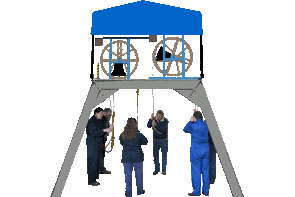
 |
The Mobile Belfries Trust - Towing a Mobile Belfry |
|
Click on the links below to navigate this site:
|
Disclaimer The information below is only for general guidance. You should make your own enquires specific to your particular vehicle and driving licence and satisfy yourself that you met all the legal requirements.
What is the legal minimun towing capacty of the verhicle rquired?
Towing capacities of cars Different variants of the same model have different maximum towing capacities. Whether it is a manual of automatic, petrol or diesel, and the engine capacity are all factors that affect the towing capacity. Cars to tow up to 1800 kg What Cars Can Tow Up To 1800kg (1.8 Tonne) (towingcapacity.co.uk) Cars to tow up to 2000 kg What Cars Can Tow Up To 2000kg (2 Tonne)? (towingcapacity.co.uk) Cars to tow up to 2500kg What Cars Can Tow Up To 2500kg (2.5 Tonne)? (towingcapacity.co.uk) Electric cars towing capacities Can electric cars tow? | What Car?
Braked and unbraked All three mobile belfries come on trailers that have integral braking systems, so they are ‘braked’ trailers.
Maximum authorised mass Maximum authorised mass (MAM) means the weight of a vehicle or trailer including the maximum load that can be carried safely when it’s being used on the road. This is also known as gross vehicle weight (GVW) or permissible maximum weight. It will be listed in the owner’s manual and is normally shown on a plate or sticker fitted to the vehicle.
Gross Train Weight The plate or sticker may also show a gross train weight (GTW), also sometimes called gross combination weight (GCW). This is the total weight of the tractor unit plus trailer plus load.
Driving licences From late 2021, all drivers are allowed to tow trailers with a maximum authorised mass (MAM) of up to 3,500kg without the need to take a car and trailer (B+E) driving test. Previously, drivers who passed their test from 1 January 1997 faced tighter towing restrictions.Drivers who passed their test before 1 January 1997 are allowed to drive a vehicle and trailer combination (e.g. GTW up to 8,250kg) The standard driving licence issued to a driver passing the test in Great Britain (not Northern Ireland) includes his or her test today covers categories B, B1 and now BE. This means that they can drive a vehicle up to 3,500kg (B) and tow a trailer up to 3500kg behind it (E). When you reach your 70th birthday slightly different rules apply if you’d like to keep towing, see the Camping & Caravanning Club driving licence guide for more information.
Insurance If you have a comprehensive insurance policy it generally covers you for towing, but some insurers only do so for third party liability. This means that while you would be covered for injury to people or property, the trailer would not be covered [Note: the Trust’s insurance covers the damage to the trailer, if the driver’s insurance does not]. Over-loading the trailer, or driving without the correct licence will invalidate the insurance.
Sources Towing with a car: What you can tow - GOV.UK (www.gov.uk) |
||||||||||||||||